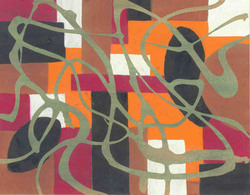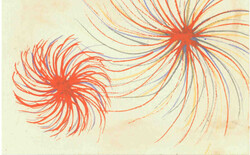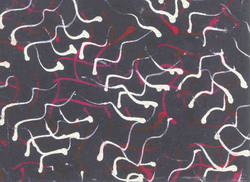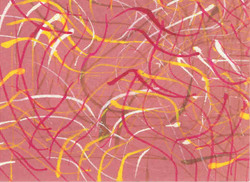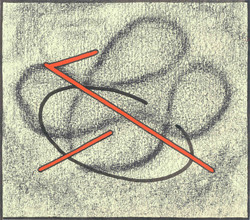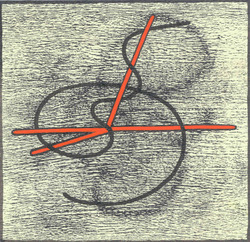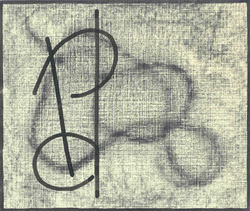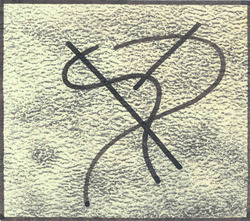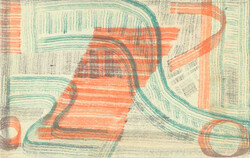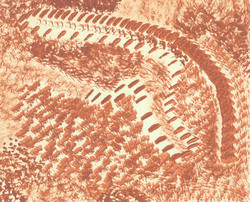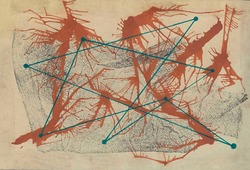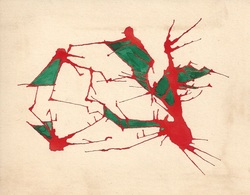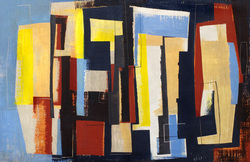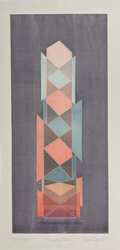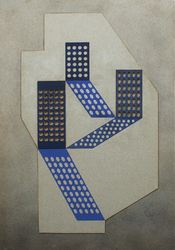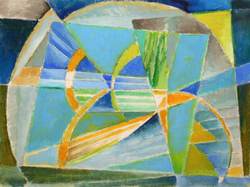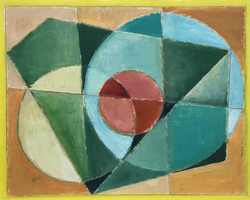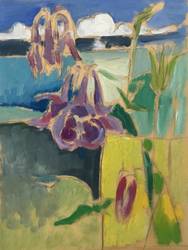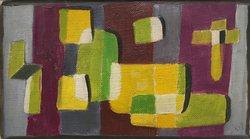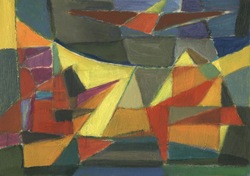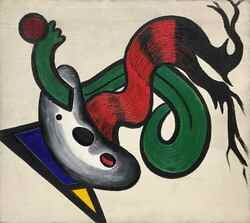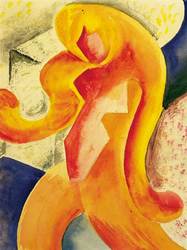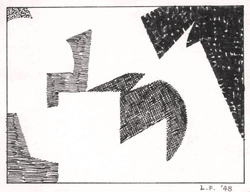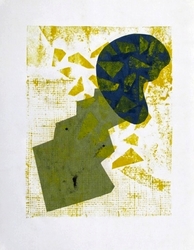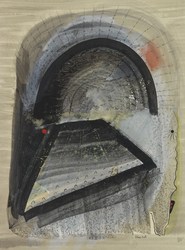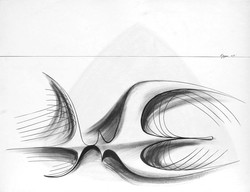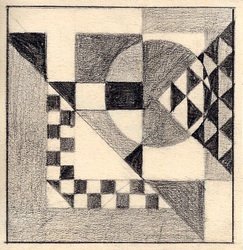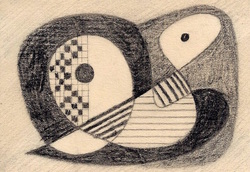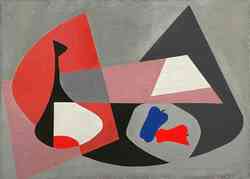New Bauhaus / Institute of Design
The New Bauhaus was founded in Chicago in 1937 by the renowned professor, photographer and artist, Laszlo Moholy-Nagy. The New Bauhaus stems from the German Bauhaus, a pioneering school of art and design that operated from 1919-1933. The theories and teachings of the Bauhaus, which emphasized a synthesis of numerous artistic disciplines, was most influential in championing Modernist Twentieth Century design, fine art and architecture. After Adolph Hitler closed the German school in 1933, many of the Bauhaus teachers, namely through the efforts of Moholy-Nagy, emmigrated to America to establish and work with the New Bauhaus in Chicago. Industrialist Walter Paepke, chairman of the Container Corporation of America, was an early financial backer of the school, which was originally located in the old Marshall Field Mansion on Chicago’s Prarie Avenue. In 1944, the school was retitled the Instiute of Design (ID) and today resides on the campus of the Illinois Institute of Technology. (IIT) The school became the first institution in the United States to offer a PhD in design. Much of Moholy-Nagy’s curriculum and ideas were outlined in his extensive 1947 book, “Vision in Motion”. Many important prefessors and designers have taught or studied at the New Bauhaus/ID. These include such artists as Serge Chermayeff, Ivan Cherymayeff, Alexander Archipenko, Buckminster Fuller, Gyorgy Kepes, Richard Koppe, Nathan Lerner, Harry Callahan, Robert Bruce Tague, John Cage and Werner Drewes, among others. Much of the influence on today’s American Modern art, design and architecture may be attributed to the teachings of the Chicago New Bauhaus
-
Joseph F. CadaAmerican, 1922 - 1993Visual Fundamentals I, Plate 1, Problem 3, 1947Gouache and watercolor on paper4 x 5 inches#18902
-
Joseph F. CadaAmerican, 1922 - 1993Visual Fundamentals I, Plate 1, Problem 3, 1947Casein on paper3 x 4 1/2 inches#
-
Joseph F. CadaAmerican, 1922 - 1993Visual Fundamentals I, Plate 1, Problem 3, 1947Casein on paper2 1/4 x 3 inches#18898
-
Joseph F. CadaAmerican, 1922 - 1993Visual Fundamentals I, Plate 1, Problem 3, 1947Casein on paper2 1/4 x 3 inches#18899
-
Joseph F. CadaAmerican, 1922 - 1993Visual Fundamentals I , 1947Gouache, ink and conte crayon5 x 5 3/4 inches#18893
-
Joseph F. CadaAmerican, 1922 - 1993Visual Fundamentals I , 1947Gouache, ink and conte crayon5 x 5 inches
Signed on reverse
#18892 -
Joseph F. CadaAmerican, 1922 - 1993Visual Fundamentals I , 1947Ink and conte crayon4 1/4 x 5 inches#18896
-
Joseph F. CadaAmerican, 1922 - 1993Visual Fundamentals I , 1947Ink and conte crayon3 1/2 x 4 inches#18897
-
Joseph F. CadaAmerican, 1922 - 1993Visual Fundamentals I, Plate 1, Problem 3, 1947Watercolor on paper3 x 4 1/2 inches#18901
-
Joseph F. CadaAmerican, 1922 - 1993Visual Fundamentals I, Plate 1, Problem 3, 1947Watercolor on paper5 x 6 inches#18903
-
Joseph F. CadaAmerican, 1922 - 1993Visual Fundamentals I, Plate 2, Problem 3, 1947Casein and ink on paper7 x 10 1/2 inches#3379
-
Joseph F. CadaAmerican, 1922 - 1993Visual Fundamentals I: Plate 1, Problem 3, 1947Gouache on paper4 1/2 x 5 1/2 inches#3373
-
Serge ChermayeffAmerican, 1900 - 1996Dawn to Dusk, Cape Cod, 1946Oil on gesso on panel, in artist's original frame24 x 36 1/4 inches
Signed, titled and dated on reverse.
#6636 -
Eugene DanaAmerican, 1912 - 1996Princeton Totem, 1985Watercolor on paper25 1/2 x 12 inches
Signed and dated Eugene Dana 9/85, lower right; Inscribed lower left and titled lower center
#19256 -
Eugene DanaAmerican, 1912 - 1996Ovals, 1941Gouache and collage construction on artist board24 x 17 inches
Signed with initials and dated E.D. 8-41, lower right; signed, titled and inscribed on reverse: Eugene Dana, August 1941, Cambridge, Mass.
#8529 -
Werner DrewesAmerican, 1899 - 1985Untitled (Abstraction)Oil on canvas board9 x 12 inches
Provenance: Estate of the artist.
#8808 -
Werner DrewesAmerican, 1899 - 1985Untitled (Abstraction)Oil on vellum6 x 7 1/2 inches
Provenance: Estate of the artist.
#15354 -
Werner DrewesAmerican, 1899 - 1985Flower Pots and Pineapple, 1945Oil on canvas8 1/4 x 6 1/2 inches
Signed Drewes, lower left; dated lower right; titled, numbered, dated and inscribed with artist’s monogram on reverse.
#4098 -
Werner DrewesAmerican, 1899 - 1985Untitled (Irises), ca. 1955Oil on vellum8 x 6 1/4 inches
Provenance: Estate of the artist.
#15353 -
Werner DrewesAmerican, 1899 - 1985Untitled (Abstraction), 1939Oil on canvas3 1/2 x 6 1/4 inches
Signed and dated with artist’s monogram lower right;
Signed and dated with artist’s monogram on reverse#14736 -
Werner DrewesAmerican, 1899 - 1985Untitled (Abstraction)Oil on vellum4 1/2 x 6 inches
Provenance: Estate of the artist.
#4109 -
Robert D. EricksonAmerican, 1917 - 1991Electric Light Socket, 1944Oil on canvas16 x 18 inches
Signed and dated on stretcher
#18891 -
Robert D. EricksonAmerican, 1917 - 1991Femme Nue, ca. 1938Watercolor on paper7 1/4 x 6 1/4 inches#15450
-
Lois FieldAmerican, b. 1923Abstraction (No. 6) , 1948Ink on paper3 x 4 inches
Signed with initials and dated L.F. ‘48 lower right; signed and dated on reverse.
#3342 -
Robert GeppertAmerican, 1925 - 2018Untitled (Abstraction, Institute of Design), ca. 1947Monoprint and collage on paper11 1/2 x 8 1/4 inches#14453
-
Lillian HallAmerican, 1905 - 2000Composition No. II, ca. 1940sGouache, watercolor and collage on paper19 1/2 x 14 1/2 inches
Signed Lillian Hall, lower right; titled on reverse.
#7322 -
Richard KoppeAmerican, 1916 - 1973Drawing #099, 1949Ink on paper19 1/2 x 25 1/2 inches
Signed and dated Koppe ‘49 upper right; numbered 099 on reverse.
#4087 -
Richard J. PavlicekAmerican,, 1916 - 2016Untitled (Abstraction), ca. 1936Graphite on paper3 1/4 x 3 1/2 inches
Signed Richard Pavlicek, on reverse.
#9698 -
Richard J. PavlicekAmerican,, 1916 - 2016Untitled (Abstraction), ca. 1936Graphite on paper3 x 4 inches#9701
-
David SegalAmerican, 1921 - 2005Untitled (Abstraction)Oil on board21 x 28 1/2 inches
Signed D. Segel, lower right
#18945
The New Bauhaus was founded in Chicago in 1937 by the renowned professor, photographer and artist, Laszlo Moholy-Nagy. The New Bauhaus stems from the German Bauhaus, a pioneering school of art and design that operated from 1919-1933. The theories and teachings of the Bauhaus, which emphasized a synthesis of numerous artistic disciplines, was most influential in championing Modernist Twentieth Century design, fine art and architecture. After Adolph Hitler closed the German school in 1933, many of the Bauhaus teachers, namely through the efforts of Moholy-Nagy, emmigrated to America to establish and work with the New Bauhaus in Chicago. Industrialist Walter Paepke, chairman of the Container Corporation of America, was an early financial backer of the school, which was originally located in the old Marshall Field Mansion on Chicago’s Prarie Avenue. In 1944, the school was retitled the Instiute of Design (ID) and today resides on the campus of the Illinois Institute of Technology. (IIT) The school became the first institution in the United States to offer a PhD in design. Much of Moholy-Nagy’s curriculum and ideas were outlined in his extensive 1947 book, “Vision in Motion”. Many important prefessors and designers have taught or studied at the New Bauhaus/ID. These include such artists as Serge Chermayeff, Ivan Cherymayeff, Alexander Archipenko, Buckminster Fuller, Gyorgy Kepes, Richard Koppe, Nathan Lerner, Harry Callahan, Robert Bruce Tague, John Cage and Werner Drewes, among others. Much of the influence on today’s American Modern art, design and architecture may be attributed to the teachings of the Chicago New Bauhaus
14-119 Merchandise Mart Plaza
Chicago, Illinois 60654
(312) 644-8855
info@richardnortongallery.com
Gallery Hours
Monday through Friday
9 am to 5 pm
©2025 Richard Norton Gallery LLC

